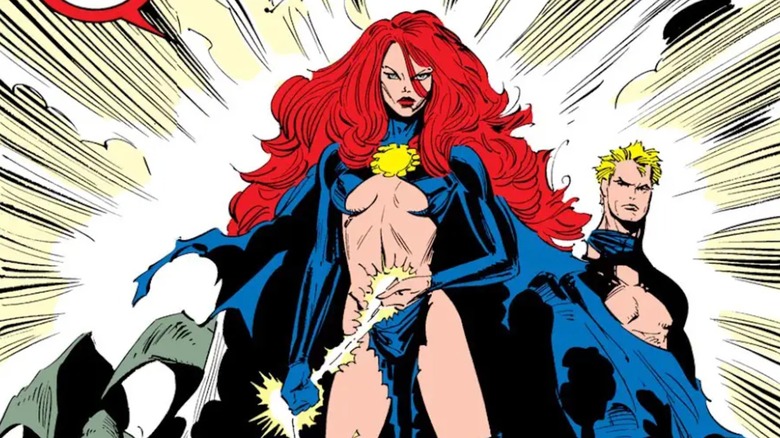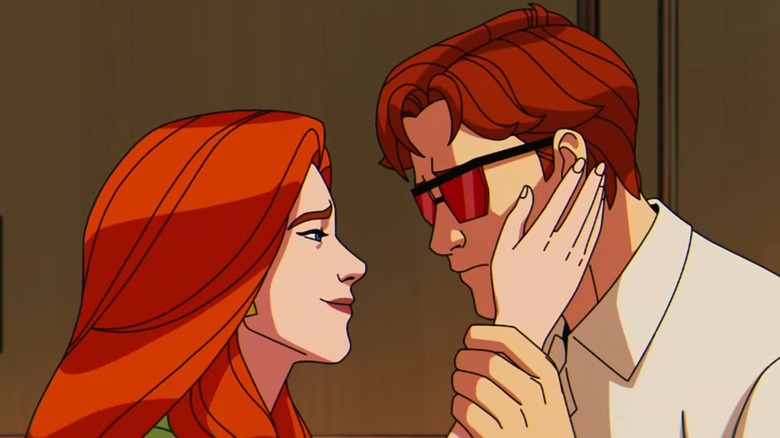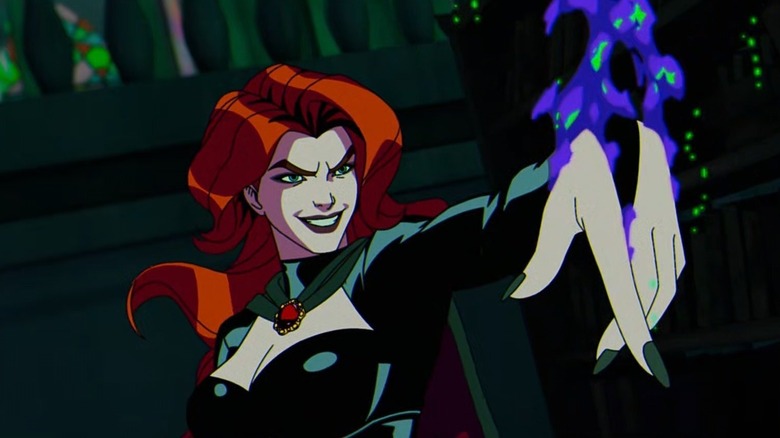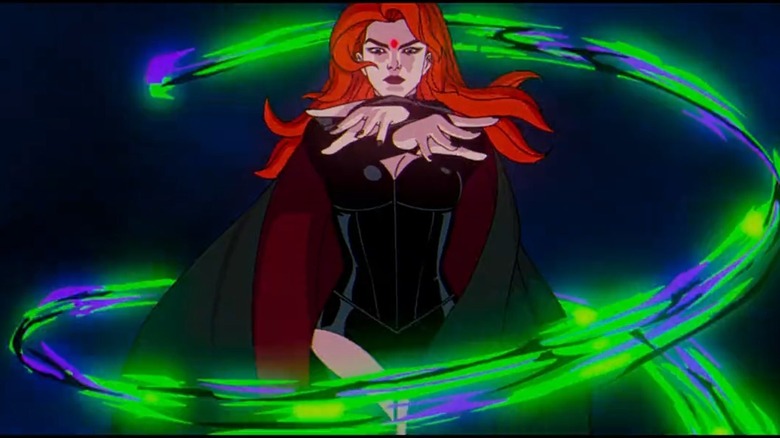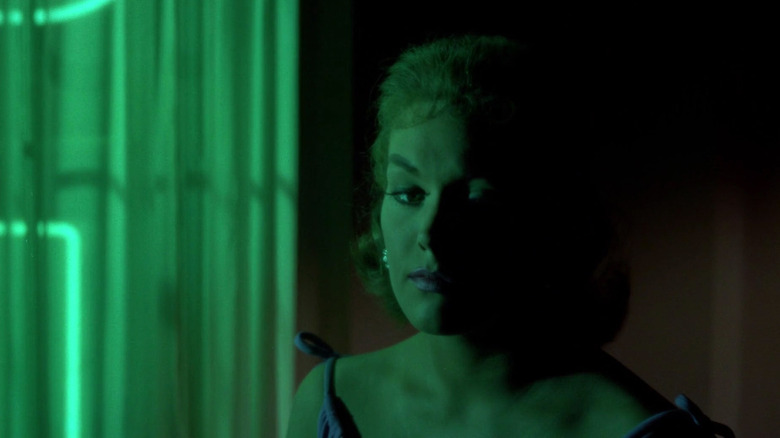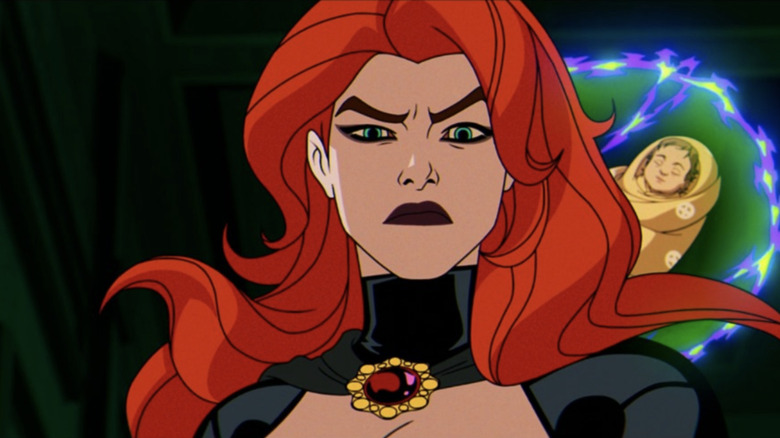Who Is Goblin Queen? Madelyne Pryor In X-Men '97 Explained
Spoilers for "X-Men '97" to follow.
"X-Men '97" episode 2, "Mutant Liberation Begins," ended with a shocking cliffhanger; a Jean Grey duplicate showed up at the door of the X-Mansion, shocking the X-Men — including the other Jean, who had only just given birth to her and Scott's son Nathan. Episode 3, "Fire Made Flesh," picks up here.
If I can brag for a moment, I called this twist from the trailer (alongside some other Marvel Comics Easter eggs). The Jean (re)introduced at the beginning of "X-Men '97" is a clone, created by Mister Sinister, while he held the original captive (Beast confirms which Jean is the original by dating the pair's cells to determine which is older).
Sinister has long wanted to combine Cyclops and Jean's DNA to create the ultimate mutant; Nathan is that experiment come to fruition. So, he confronts his "daughter" (who's feeling susceptible after her entire life had been torn asunder) and induces her to attack the X-Men. Her psychic powers now accompanied by green fire, the Jean clone creates a new black costume for herself and uses her powers to psychically trap the X-Men in a vision of Hell.
The clone declares: "I am beyond Jean Grey, beyond the X-Men! I am scorn and fury forged in righteous brimstone! I am the Goblin Queen!" This mirrors Jean's speech when she became the Phoenix: "I am Fire! And Life incarnate! Now and forever — I am PHOENIX!" The transformation goes beyond costume: her eyebrows get darker and sharper, her skin paler, her voice sultrier/hammier and her posture vivacious. Ultimately, Jean pulls her "sister" back to the side of light and they defeat Sinister. She leaves the X-Men to start a new life as "Madelyne Pryor."
Why did she choose that name? The answers lie in the comics ... and that story is a lot more complicated.
Red Headed Stranger
The comic book "Dark Phoenix Saga" ended with Jean dying, sacrificing her life to destroy the fiery demon within her. Uatu The Watcher closes the story by musing: "Jean Grey could have lived to become a god. But it was more important to her that she die ... a human."
In "Uncanny X-Men" issue #168 (by Chris Claremont and Paul Smith), a still-mourning Cyclops visits his grandparents in Alaska and meets Madelyne Pryor, a pilot working for them. She looks exactly like Jean and, though smitten, Scott harbors suspicions she might be the Phoenix returned to life. This culminates in "Uncanny X-Men" #174-175 when psychic villain Mastermind (who played a big role in Jean's downfall during "The Dark Phoenix Saga," only to have her fry his brain) tries to avenge himself. He uses his illusory powers to trick the X-Men into thinking Madelyne is a resurrected Dark Phoenix but is ultimately defeated. #175 ends with Scott finally making peace before Jean's grave, and then he and Madelyne wed.
Claremont planned for Scott and Madelyne to settle down after this, with Scott retiring from the X-Men to be a family man:
"Scott was going to move on. Jean was dead, [so] get on with your life. And it was close to be a happy ending. They lived happily ever after, and it was to create the impression that maybe if you came back in 10 years, other X-Men would have grown up and out, too. Would Kitty stay with the team forever? Would Nightcrawler? Would any of them? Because that way we could evolve them into new directions, we could bring in new characters. There would be an ongoing sense of renewal, and growth and change in a positive sense."
An Inferno fit for a Goblin Queen
But then, Jean was resurrected in "Fantastic Four" issue #286 (by "Dark Phoenix Saga" artist John Byrne, who was then the regular writer/artist on "Fantastic Four"). This led to "X-Factor," a series where the original five X-Men (Cyclops, Jean, Beast, Iceman, and Angel) reunite on a new team. This compromised Claremont's plans for Scott and Maddie; Scott dumped his family (including his and Maddie's son Nathan) to get back together with Jean. (In "X-Men '97," Scott doesn't abandon Madelyne for the old Jean, he's merely confused, and Madelyne's behavior is more down to Sinister's manipulation and her identity crisis. Both characters come out more sympathetic than they do in the comics.)
In turn, that led to the crossover "Inferno" (which you should really read if you like "X-Men '97"), split between Claremont's "Uncanny X-Men" and Louise Simonson's "X-Factor." Feeling vengeful towards Scott, Madelyne makes a pact with demonic forces to merge Earth and the realm of Limbo, resulting in demons invading New York under her command as their Goblin Queen.
"Uncanny X-Men" #240-241 (part of "Inferno") revealed Madelyne is a creation of Mister Sinister and Claremont's original red herring — that Miss Pryor was a clone of Jean — was her true origin all along. Both Madelyne and Sinister are defeated, Limbo is disentangled from the mortal realm, and Jean/The Phoenix Force absorbs Madelyne's memory.
To underscore just how much this was not the plan, Mister Sinister was first alluded to in "Uncanny X-Men" #212, 50+ issues after Madelyne appeared. Still, "Inferno" is a good time. It may not be the most politically-conscious "X-Men" story like "God Loves, Man Kills," but as a soap opera spectacle, it rules. The spectacular art (by Marc Silvestri in "X-Men" and Walt Simonson in "X-Factor"), from the action scenes to the creepy demon hordes, definitely helps.
Fire of the Phoenix
The original 1992 "X-Men" cartoon series adapted "The Dark Phoenix Saga" in its third season. It ended differently though; after Jean's sacrifice, the Phoenix Force returns her to life (each of the X-Men volunteers a portion of their life energy) and then departs. That means the animated Cyclops never went through a period of believing Jean was dead, and so never fell in love with Madelyne believing she was a separate person.
The animated Madelyne was created by Sinister explicitly to replace Jean on the X-Men as a sleeper agent. The comic Madelyne, though, never believed that she was the real Jean Grey like the animated one did. The scene in "Fire Made Flesh" where the two Jeans remember the death of their childhood friend Annie Richardson is loosely pulled from "Uncanny X-Men" #241, when Sinister shows the memory to Madelyne. There, though, Madelyne had assumed it was her unique childhood memory, not one copied from Jean.
"Fire Made Flesh" also makes a brave move and never reveals when Jean and Madelyne were swapped. It's even suggested in the episode that Madelyne could have been the Dark Phoenix, not Jean. For what it's worth, Sinister abducted Cyclops and Jean way back in season 2 of "X-Men," so the switch could've easily happened that early (if you need any other animated "X-Men" refreshers, click here). I think this choice is to better support Madelyne's personhood; she's not just the disposable clone the comics rewrote her into, she's as much Jean Grey as the original, hence the happier ending than "Inferno" (more on that later.)
The influence of Vertigo
Animated Madelyne declares "[The X-Men] shall know my Inferno!", but unlike that comic, they aren't battling real demonic hordes, just simple illusions. This is confirmed when the real Jean clears the Goblin Queen's demons away using her own psychic powers. This makes the demonic imagery of the Goblin Queen in "X-Men '97," down to that very name, feel like an unmotivated choice; comic Madelyne was literally becoming a Goblin Queen thanks to the demonic pact she made, whereas the animated one just picked it to sound as sinister as her creator.
The name "Madelyne Pryor" also feels out of the blue, but there's an explanation. "Pryor," as the woman herself explains in "X-Factor" #38 (part of "Inferno"), is a joke on Sinister's part; as a clone, she's birthed from a prior existence. As for Madelyne? That's a Hitchcock reference.
In "Vertigo," Jimmy Stewart plays Scottie Ferguson, a man who falls in love with a woman named Madeleine (Kim Novak). After Madeleine dies, Scottie meets her doppelganger, Judy, and tries to mold her into a replacement for his lost love. It turns out Judy is Madeleine as Scottie knew her; she was impersonating the real Madeleine as part of an elaborate con but did fall for her mark. The names are a bit different (Scottie versus Scott, Madeleine versus Madelyne), but Cyclops and the Goblin Queen's twisted romance is like a version of "Vertigo" starring the X-Men.
Claremont's influence comes out in the Goblin Queen's costume (even if it's toned down from the midriff-baring comic version) and dialogue; in "Fire Made Flesh," she tells Magneto "I should have you as a toy." Claremont's "X-Men" work is dripping with BDSM imagery (look at Emma Frost), "Inferno" absolutely included.
Return of the Goblin Queen
So, will "X-Men '97" bring back Madelyne? She's not a villain anymore, unlike in the comics where she's been the Goblin Queen since "Inferno." Plus, her story arc on the show is completed for the time being; "Jean" had been saying since "X-Men '97" episode 1 that she wanted to leave the X-Men behind, and she does so even if it's without Scott.
However, there may be a few ways we see her again. One concerns her son. In "Fire Made Flesh," Sinister infects young Nathan with a techno-organic virus, so his parents send him into the future with time-traveling X-Man Bishop. In case you don't know, this set up Nathan to become the time-traveling mercenary Cable, who was a recurring character back in the original "X-Men" animated series. Madelyne and her adult son meeting holds dramatic potential.
In the comics, Madelyne also hooked up with Scott's younger brother Alex Summers/Havok after Cyclops dumped her; he stood by the Goblin Queen's side as a brainwashed servant/boy toy during "Inferno." Havok appeared in the "X-Men" episode "Cold Comfort," but he and Scott didn't realize that they're long-lost brothers. If Madelyne returns with Alex in tow, there could be a bigger Summers family reunion.
"X-Men '97" is streaming on Disney+, with new episodes releasing on Wednesdays.
